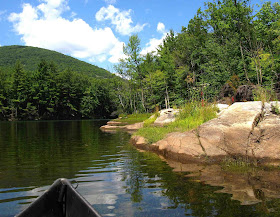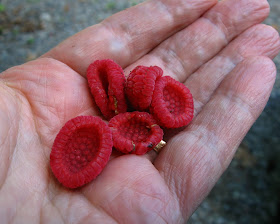It's a lazy afternoon,
and the beetle bugs are zoomin'
and the tulip trees are bloomin'
and there's not another human in view. . . .
That old song from the 1950s kept going around in my head today as I drifted along the Hudson banks, enjoying this beautiful summer day with a leisurely paddle on a river I had all to myself.

Puffy white clouds drifted across a radiant blue sky, while sunshine lit up the vivid Cardinal
Flowers and Golden Pert that sprouted from every crevice in the rocks and lined the shore.
With my little lightweight canoe I could ease right into the shallows close to shore, where the woodsy fragrance of the shady forest tumbled over the banks, and green carpets of Golden Pert flourished just under the surface of the water.
Dragonflies of many kinds were zooming over the water, but only this Slatey Blue landed long enough for me to get a photo.
This Live Forever, a kind of wild sedum, was just coming into flower. Although most of its buds were still tightly closed, they were colored a vivid velvety magenta.
There's no denying this Purple Loosestrife looks gorgeous, set off by the sunny yellow Helenium. Too bad I had to pull it out. For at least ten years, I've been destroying this aggressive alien interloper wherever I find it along these shores, and now I find just a few each summer.
One plant that seems to be really thriving this summer is Wild Celery, a native water plant that's a favorite food of ducks and other water fowl. I don't recall ever seeing such masses of it growing in every bay, its little white female flowers held just at the surface by shiny curlicue stems. A year ago, this bay was choked with Eurasion Milfoil, but this year I could find only a few of the milfoil's feathery stems. (You can see one of those pinky-green milfoil stems in the center foreground of this photo.) Could it be that the Wild Celery has supplanted this nasty invasive?
Here's a close-up view of a Wild Celery female flower.

The male flowers, which grow underwater at the base of separate plants, are much, much smaller. When ripe, they rise to the surface and tumble into the little dimples the female flowers produce in the surface tension of the water. Once the flowers are fertilized, the curlicue stems tightly recoil and deposit the flowers down into the mud at the bottom of the river, where they will produce new plants.
I found a number of drifting masses of bladderwort, identified as such by all those little sacs on the thready stems. I'm not sure what species this is, perhaps the Humped Bladderwort I found a week or so ago, although I have yet to see any bladderworts of any kind blooming along these shores.
After paddling for several hours, I began to regret that I'd failed to bring anything to drink. So I was delighted to find a bunch of Purple-flowered Raspberries, laden with fruit. Somebody once told me this fruit was not fit to eat, but that person must have wanted to save it all for himself. The berries are actually quite delicious, both tangy and sweet with a velvety soft texture, and no seeds to stick in your teeth. They're also quite large, so it didn't take long to pick a nice handful. Yum!
Heading for home, I was climbing a hill in the woods when Whoa! There was this INDIAN, all dressed in loincloth and feathers and moccasins, his face done up with warpaint, carrying a long gun. Did I feel afraid? No, not even for a moment, since I also saw this white bearded guy with a camera, and he was yelling "Action!"

Turns out, I'd stumbled upon a Dutch film crew making a historical documentary about the Dutch in the Hudson River Valley. Among other places. The name of their project is "Amsterdam Stories USA: A road movie through 16 amsterdams," and you can read all about it at their website by clicking here. They'll be visiting 16 different cities or towns called Amsterdam across the United States, including what was once called New Amsterdam, that is, New York. I didn't quite get what the Indian guy had to do with the story, but it turns out he really is an Indian named Richard Salazar, and he's not Dutch but lives right here in Moreau and is known for his presentations regarding Native American culture. And yes, he sure looked the part.








What a great story! all those beautiful flowers and fascinating plants, and then, the Amsterdam filming! What comic and dramatic effect. I wonder how many Amsterdams there are across the U.S. Probably better he ended up filming NY's Amsterdam in Moreau than in the actual city! Kind of reminds me of the guy named Murphy who visited all the Murphy's Bars in Ireland (and then published the book).
ReplyDeleteThat was a wonderful trip. You certainly do have a wonderful place to wander through and document. I always learn so much, about flowers and plants that I didn't even know existed. Thanks for sharing this journey.
ReplyDeleteWhat a fabulous day to be out there !
ReplyDeleteAnd then what a surprise for you to run into my ex-hubby Rick -- we did always have fun doing historical reenacting -
yes there's adventure around every corner in this neck of the woods...